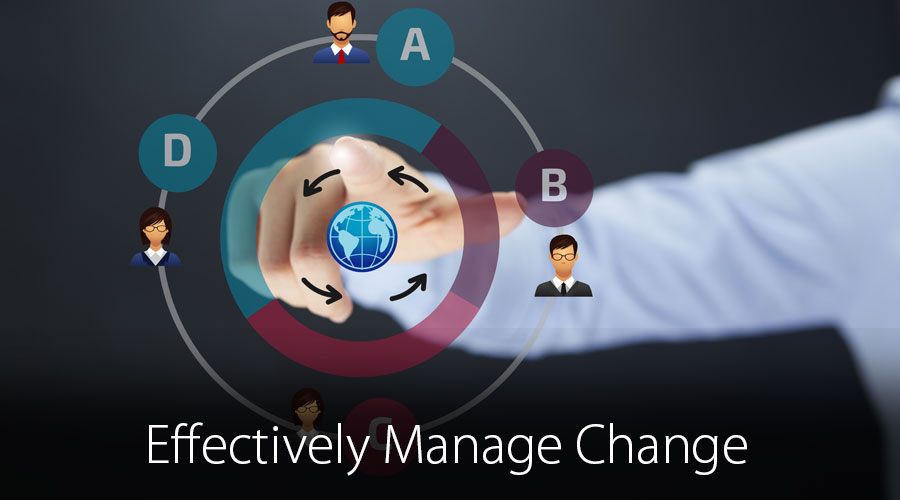Updated June 9, 2023
There is nothing permanent except change
Effectively Manage Change
A conductor working on busy Indian roads retired after a service period of 35 years. Getting bored sitting at home, he decided to take up a simple job nearby, which would keep him occupied and bring in some income. Fortunately, a shopkeeper nearby was looking for an account keeper for his business, for which the conductor happily volunteered.
The next day, when the owner of the business walked in, he was shocked to see a small boy beside the table shaking it as the conductor wrote the accounts. When questioned, the conductor replied, “I am used to writing on moving the bus. I found it quite difficult to write sitting on this still table. Hence, I asked the boy to shake the table so I could write without trouble”.
Change in the working environment is not easy for everyone. We stick to our old ways of doing things, even if that is not easy or right.
Image source: pixabay.comWhy is it so hard to adapt to Effectively managing change? Though it is inevitable in every aspect of our life, it is not always easy to manage change Effectively. We try to hold on to our comfort zones even if they are uncomfortable for familiarity.
Sometimes it is within us and challenges us, whereas, at other times, we face external changes that impact our lives. Blowing the challenge out of proportion can happen when we don’t have control over it and haven’t initiated it.
Change can occur due to personal upheavals and political factors, economic sways, changing social trends, and advancement of technology and science. One of the biggest challenges people faced in the 20th century was the introduction of computers and the Internet in workplaces. It also gave rise to the term technophobia, which means the individual suffers from fear or dislike or electronic gadgets, especially computers. People with apprehensions about accepting evolution in technology were left behind and also lost their jobs because they failed to manage it.
 Image source: pixabay.com
Image source: pixabay.com
There is always underlying fear and apprehension regarding administrative or technological setup in an organization since employees or even the management relate it to reducing or completely eliminating their role. This leads to employees developing solid resistance strategies to stop Effectively managing change.
Achievers and leaders are not different from regular people, but what makes them stand apart is their exceptional ability to welcome them with open arms. It is not the excitement or adventure of Effectively managing the change that attracts such people. Still, their belief in adaptability and management of change helps them overcome their fear, apprehensions, and resistance to it.
Changes take place in organizations constantly due to either internal or external factors. It is not always welcome by employees, mainly when the higher authorities have initiated the change with expectations to be met by the employees.
What are the essential steps we can take to manage it in our organization without negatively affecting it but using it as stepping stones for success?
Rules and Principles that Help in Effectively managing change management
Let us explore ten rules and principles that help Effectively manage change management.
-
Step Out Of the Comfort Zone
Employees in an organization tend to hold on to the age-old symbols, formalities, language, and values that give them a sense of continuity and stability in the workplace. This creates a comfort zone for them over some time. They may feel driven by fear and apprehension when change occurs, as it may require them to leave their comfort zone.
Though we all love and hold on to comfort, discomfort is integral to any success story. There may be just a few people who have succeeded by staying inside their comfort zone and never taking risks. We must step out of our comfort zone and challenge ourselves to be ready for change because it is nothing but transformation and progress.
We must overcome our fear of discomfort, which keeps us bound to our comfort zone. Though this sounds easy, it is tough to be there and do it; a firm resolution will see us go through with flying colors. Make every challenge a learning experience to acquire new skills and knowledge.
-
Understand the Cause Behind the Change
There is always a reason, cause, and purpose for every effective change that takes place in an organization. Resistance and reluctance to change often come when the team doesn’t understand the meaning or cause of the Effectively managed change. Acceptance of the change is more likely once we understand the reasons behind the implementation.
We should try to understand why the organization is opting for Effectively managing change without being biased. Most changes are implemented to make things better. However, the organization may sometimes have to bring about a change for its benefits, like saving costs or increasing profit, which may not be beneficial to the employee. Whatever the reason behind the change, it is always good to have a transparent, unbiased, non-judgmental view of the change and its cause.
-
Build Future Vision Around the Change
Bernard Shaw said, “Progress is impossible without Effectively managing change, and those who cannot change their minds cannot change anything.” Change your attitude and resistance towards change; instead, build your future vision in your organization.
Our organization will have a facelift with the change taking place and will look different. Most changes improve the working environment, with benefits equally distributed among the employees, organization, and customers. The full impact will take some time; hence, we have to be prepared for challenges in the early stages.
Framing a positive vision of the future around the change can help us handle initial setbacks and challenges without becoming frustrated or irritated. We should help our team to see our image to motivate and inspire them. A highly inspired and motivated team effectively manages change, however challenging and less problematic.
-
Be Informed
With Effectively managing change comes confusion and doubts. It is important to stay informed about the strategies, plans, and steps involved in the change process that will unfold over a certain period of time. Being informed will make us feel we are in the driver’s seat, which is good even when the ride is rough.
We can share and collect information through reports, memos, group presentations, or individual discussions. We should not hesitate to ask questions to gather or share information with those looking for it.
Have every detail worked out so that there will be a clear idea about its implications on everyday work schedules. Having the information on hand equips us better to deal with issues arising from it.
-
Communicate Doubts and Fears
The organization and top-level management committee may have no idea about the doubts and fears that inhibit the minds of their employees. Since they clearly understand the cause, they are sure it is necessary and have a vision of a bright future; they can expect the same from other team members. We must communicate our doubts and fears to solicit their input and feedback for reassurance.
A question and answer session between employees and the change implementation committee can increase transparency and help clear out doubts and fears surrounding the change. We should be specific with our questions instead of throwing clues, giving hints, or using vague language.
Leaving doubts and fears unaddressed can lead to rumors and gossip, which can further contribute to the confusion already present.
-
Be Involved
Active involvement in the change management process within our organization is the most rewarding aspect of effectively managing change. Being a part of the implementation and design team for the change will help us clarify the facts and step-by-step procedure of how things will take place.
By being a passive receiver, we will lose a lifetime opportunity of being a decision-maker and active participant in the transformation, which may leave an impact for years. With our experience in the organization, we can give beneficial inputs to the team.
 Image source: pixabay.com
Image source: pixabay.com
Participating in how to manage the change process effectively will also help us feel like we are initiating the change rather than being victims of unwanted change. More than the situation itself, our attitude makes a lot of difference to our career development along with the change taking place. So let us change our passive attitude to an active one and learn how to manage change effectively.
-
Don’t Quit
It is not everyone’s cup of tea to face the challenge instead of quitting and running away. Change becomes overwhelming if it requires employees to adopt an entirely new way of functioning or learn a previously unknown skill set. Many of us tend to quit and avoid the challenge instead of taking it as a chance to become better-equipped employees. The introduction of computers into workplaces for data storage made this quite obvious. It scared the old timers who were used to bookkeeping into quitting. But, in a few years, there was no job where they could work without using computers. Those who tried to learn the new skill made tremendous progress, and those who quit suffered losses.
We have to remember that winner never quit, and quitters never win. All we have to do is belief in the cause, have faith in ourselves, be dedicated, and never think of quitting. So often, people have realized that the new skill or performance method is much better than their previous way of functioning. Change is here for a reason: to make things better than it previously was. Perseverance and tenacity will show that we will adapt to the demands of effectively managing change and becoming more competent employees.
-
Be Committed
Initiating change as part of a cost reduction initiative can test our dedication, commitment to the organization, and trust. We may have to work extra hours for lesser pay, but we will become valued employees for our organization for standing by them in tough times.
The commitment of the employees is the backbone of any organization. No company can make progress or bring about how to effectively manage change without trustworthy and dedicated employees. Since we are part of an organization, we grow as the organization grows. Implementing change may be challenging, but it can bring progress for the company.
By standing by our organization, we can set an example for those who don’t have the self-reliance or experience to face hard times and hold out for the rewards of success.
-
Overcome Fear Of Failure
When we do not have enough trust in our competencies, we fear failure in our performance, mainly when a change occurs in the organization. No one enjoys coming out as incompetent or stupid, leading to resistance to change.
To hide their fear of their skill being obsolete or not good enough for the new change taking place, employees often show resistance, become skeptical about the success of the change or just quit. Let us not allow our irrational fears or limited vision to prevent us from making progress.
-
Own Responsibility
Let us not wait in the shadows, being skeptical about the change or doubting its success. Let us take the opportunity to unleash the leader in us who is willing to accept responsibility for making change happen and make it a huge success.
Image source: pixabay.comLet’s identify any problems that might be barriers to change so we can take appropriate action to overcome them. Instead of making this problem our chance to oppose or resist managing change effectively, let us craft solutions for issues like employees fighting change, lack of knowledge or training required in the human resource, and inadequate equipment or resources, which is essential for how to manage change effectively.
With proper support, we can celebrate the success of change implementation and dream of more significant changes for our organization.
Recommended Articles
Guide to Manage Change Effectively. Here we have discussed the 10 Rules and principles that help in Effectively managing change management. You can go through our suggested articles –




